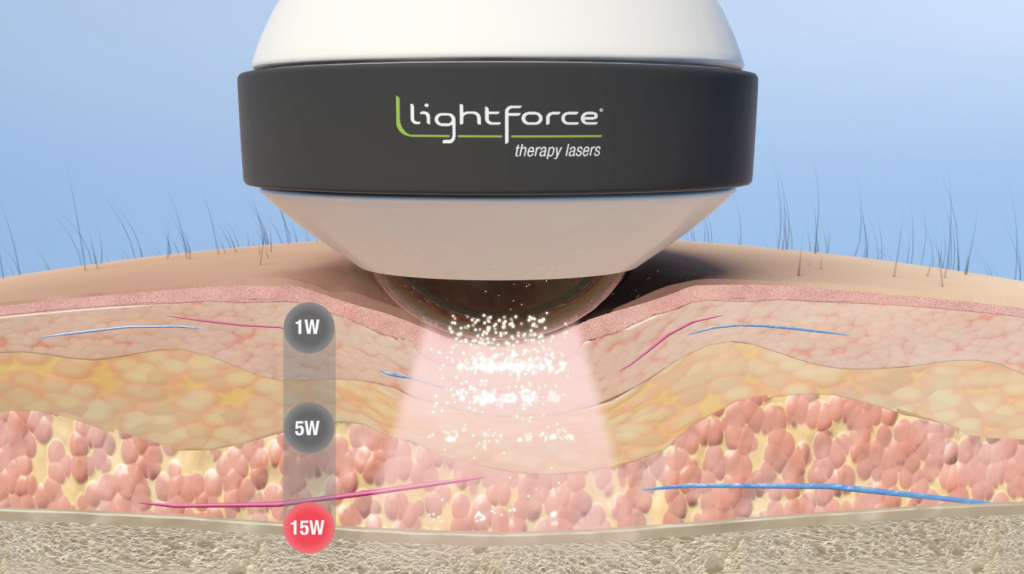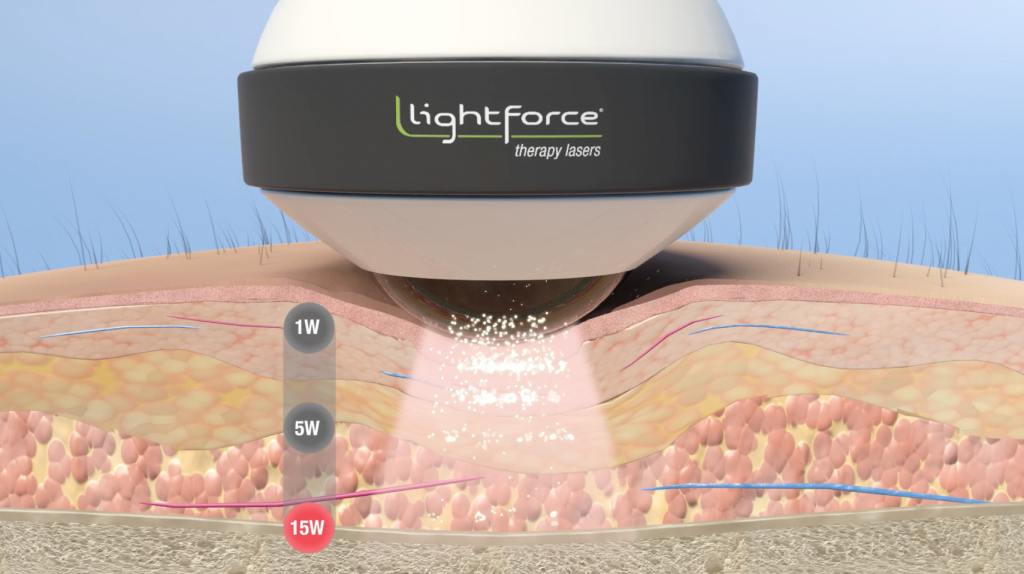Laser Forum – Part 2: Understanding The Impact of Power on Photobiomodulation (PBM)
Contributed by Mark Callanen, PT, DPT, OCS
In Part 1 of this laser forum, we discussed the basic terms related to the physics of laser therapy. Here we will cover the significant role irradiance (power density) and dosage (energy density) plays in 3 concepts pertinent to photobiomodulation (PBM) therapy.
1. Higher irradiance allows more photons to be applied at depth for a given wavelength. Please refer to the image below for a visual representation of this concept.

This is important with regard to PBM as it is a threshold-phenomena. If sufficient light does not reach the injured target tissue, there will be no notable therapeutic change1. Higher powered lasers can help with this problem by providing higher photonic density at the skin which helps transfer proportionate levels of light to deeper tissues. This concept can be referred to as “therapeutic depth”. It is worth noting that this is a complicated topic that goes well beyond the scope of this article and that there are several variables that impact optimal tissue dosing.
2. When treating with a laser, it can be difficult to maintain therapeutic dosing levels when treating over large surface areas. This is because as the treatment area grows, so does the denominator of the energy density equation (J/cm2) which can dilute the dose of energy being applied if higher joule levels are not applied proportionately. Having more laser power to utilize makes this adjustment easier for the clinician. Note: (J = W x s).
The graphic below helps clarify how adding power impacts treatment time for a given energy density and a given area.

In summary, adding power to the energy equation can significantly reduce the time needed to apply a therapeutic PBM dose of light.
3. The final important clinical factor that higher irradiance impacts is with regard to pain relief. More specifically, analgesia that can be created at peripheral sensory nerves when higher irradiances are applied to C and A-delta sensory nerves. It has been shown that when > 270 mW/cm2 is applied to these nerves, neuroplastic changes take place within 2-3 minutes at the peripheral nerve that slows the conduction rate of the pain signal3. This physical change to the nerve quickly reduces pain4.
Additionally, it has been shown that an inhibition of nociceptive action potentials takes place when higher power densities are applied to nerve tissue. Specifically, a 30% neural blockade has been shown to start 10-20 min after treatment, which further reduces pain perception4.
There are other longer lasting benefits that PBM provides with regard to reducing inflammation around damaged tissue, but this is a mechanism of healing that is not unique to treatment with higher irradiances1,2,4.
One final note with regard to safety, treating with higher power density does increase the risk of thermal effects on surface tissue as more heat is produced. Using ideal wavelengths that minimize photonic absorption at the skin and utilizing appropriate treatment heads that help manage surface heat is an important component to consider when treating with Class 4 lasers. LightForce Therapy Lasers influence® Technology helps to easily manage these factors through a combination of patented software and hardware features. The patented large massage ball and large cone applicators play an integral role in delivering high powered treatments that are safe and comfortable to the patient.
If after reading this you still have questions about the effectiveness of higher powered lasers, please watch this informative animation, or contact us directly at info@lightforcelasers.com.
References1. Huang, Y. Biphasic Dose Response in Low Level Light Therapy. Dose Response. 2009; 7(4): 358–383.
2. Bjordal JM, Couppe C, Chow RT, Tuner J, Ljunggren EA. A systematic review of low level laser therapy with location-specific doses for pain from chronic joint disorders. Aust J Physiother. 2003;49:107–16.
3. Holanda, V.M. et al. (2017) The Mechanistic Basis for Photobiomodulation Therapy of Neuropathic Pain by Near Infrared Laser Light. Lasers Surg Med. 2017 Jul;49(5):516-524
4. Cotler, H et al. The Use of Low Level Laser Therapy (LLLT) For Musculoskeletal Pain. MOJ Orthop Rheumatol. 2015 ; 2(5).

Comments